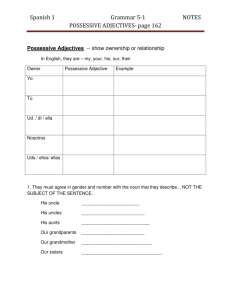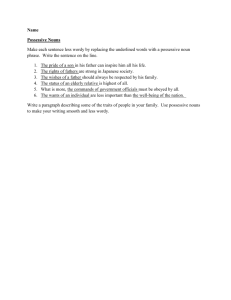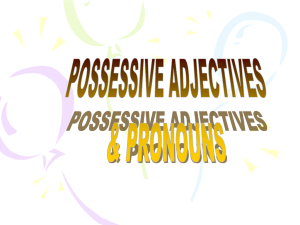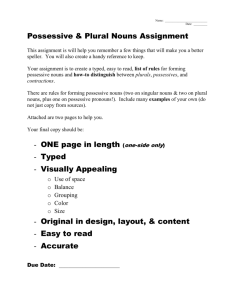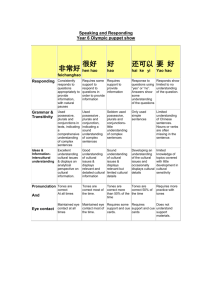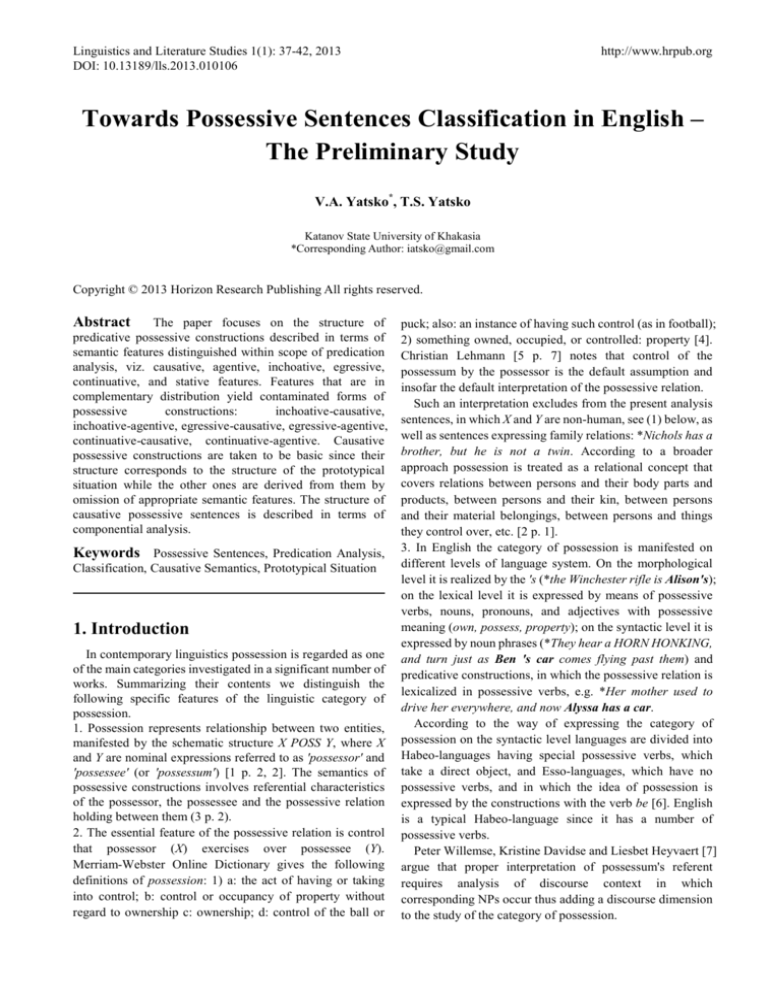
Linguistics and Literature Studies 1(1): 37-42, 2013
DOI: 10.13189/lls.2013.010106
http://www.hrpub.org
Towards Possessive Sentences Classification in English –
The Preliminary Study
V.A. Yatsko*, T.S. Yatsko
Katanov State University of Khakasia
*Corresponding Author: iatsko@gmail.com
Copyright © 2013 Horizon Research Publishing All rights reserved.
Abstract The paper focuses on the structure of
predicative possessive constructions described in terms of
semantic features distinguished within scope of predication
analysis, viz. causative, agentive, inchoative, egressive,
continuative, and stative features. Features that are in
complementary distribution yield contaminated forms of
possessive
constructions:
inchoative-causative,
inchoative-agentive, egressive-causative, egressive-agentive,
continuative-causative, continuative-agentive. Causative
possessive constructions are taken to be basic since their
structure corresponds to the structure of the prototypical
situation while the other ones are derived from them by
omission of appropriate semantic features. The structure of
causative possessive sentences is described in terms of
componential analysis.
Keywords Possessive Sentences, Predication Analysis,
Classification, Causative Semantics, Prototypical Situation
1. Introduction
In contemporary linguistics possession is regarded as one
of the main categories investigated in a significant number of
works. Summarizing their contents we distinguish the
following specific features of the linguistic category of
possession.
1. Possession represents relationship between two entities,
manifested by the schematic structure X POSS Y, where X
and Y are nominal expressions referred to as 'possessor' and
'possessee' (or 'possessum') [1 p. 2, 2]. The semantics of
possessive constructions involves referential characteristics
of the possessor, the possessee and the possessive relation
holding between them (3 p. 2).
2. The essential feature of the possessive relation is control
that possessor (X) exercises over possessee (Y).
Merriam-Webster Online Dictionary gives the following
definitions of possession: 1) a: the act of having or taking
into control; b: control or occupancy of property without
regard to ownership c: ownership; d: control of the ball or
puck; also: an instance of having such control (as in football);
2) something owned, occupied, or controlled: property [4].
Christian Lehmann [5 p. 7] notes that control of the
possessum by the possessor is the default assumption and
insofar the default interpretation of the possessive relation.
Such an interpretation excludes from the present analysis
sentences, in which X and Y are non-human, see (1) below, as
well as sentences expressing family relations: *Nichols has a
brother, but he is not a twin. According to a broader
approach possession is treated as a relational concept that
covers relations between persons and their body parts and
products, between persons and their kin, between persons
and their material belongings, between persons and things
they control over, etc. [2 p. 1].
3. In English the category of possession is manifested on
different levels of language system. On the morphological
level it is realized by the 's (*the Winchester rifle is Alison's);
on the lexical level it is expressed by means of possessive
verbs, nouns, pronouns, and adjectives with possessive
meaning (own, possess, property); on the syntactic level it is
expressed by noun phrases (*They hear a HORN HONKING,
and turn just as Ben 's car comes flying past them) and
predicative constructions, in which the possessive relation is
lexicalized in possessive verbs, e.g. *Her mother used to
drive her everywhere, and now Alyssa has a car.
According to the way of expressing the category of
possession on the syntactic level languages are divided into
Habeo-languages having special possessive verbs, which
take a direct object, and Esso-languages, which have no
possessive verbs, and in which the idea of possession is
expressed by the constructions with the verb be [6]. English
is a typical Habeo-language since it has a number of
possessive verbs.
Peter Willemse, Kristine Davidse and Liesbet Heyvaert [7]
argue that proper interpretation of possessum's referent
requires analysis of discourse context in which
corresponding NPs occur thus adding a discourse dimension
to the study of the category of possession.
38
Towards Possessive Sentences Classification in English – The Preliminary Study
Linguistic studies of the category of possession usually
differentiate between nominal possessives and clausal
possessives [8]. This paper will concentrate on predicative
possessive constructions since they have been less
investigated and there is need in new methodologies for their
analysis.
4. Linguistic investigations of the category of possession
have been focused on developing the taxonomy of
possessive constructions, characterization of their types and
subtypes. John R. Taylor [1 p. 6] provides evidence that the
first such taxonomy was created by H. Poutsma in the work
dated as early as 1914. Since that time a number of
taxonomies have been created that take into account
semantic, syntactic, and pragmatic characteristics of X, Y and
POSS. As we showed earlier [9] the taxonomies have been
developed within scopes of two approaches. The taxonomic
approach is based on the principle of a univocal
correspondence between the linguistic form and content: any
construction that contains lexical and grammatical
manifestations of possession is considered possessive. The
restrictive approach holds that lexical and grammatical
possessive markers can express not only possessive meaning
but also other types of meaning such as existence or location.
For example (1) within scope of the taxonomic approach
will be regarded as a possessive sentence (since it features
the possessive marker has) while according to the restrictive
approach being possessive in form it is existential by its
nature.
(1) *The house has several bedrooms
Existential semantics of (1) can be revealed by application
of interrogation test, cf.: Are there bedrooms in the house? Yes, the house has several bedrooms. Existential nature of
the sentence is clearly indicated by There + be construction.
Other tests used to detect the semantics of possessive
constructions include transposition of X and Y; substitution;
insertion; deletion; transformation of predicative
constructions into non-predicative and vice versa. These
tests correspond to those ones used in transformational
grammar as constituency tests [10 pp. 24-33).
Another assumption underlying the restrictive approach is
that possessive semantics can vary in its intensity; in some
contexts it can be completely or partially neutralized.
The aim of this paper is to suggest a novel approach to
classification of possessive sentences based on predication
analysis methodology. We will focus on the analysis of
causative sentences that, in our opinion, are prototypical to
the domain of alienable possession and reveal some factors
that influence the intensity of possessive semantics and
determine its gradational character.
The examples of predicative constructions were taken
from the Corpus of Contemporary American English [11]
(these are marked with an asterisk) and the British National
Corpus (marked with double asterisk) [12]. Both corpora are
available online, which makes it possible to easily verify
presented data and their analysis.
2. Predication Analysis
The term "predication analysis" was introduced by Laurel
Brinton [13 pp. 276-287]. Depending on the distribution of
semantic features of predicates Brinton distinguishes
between stative, inchoative, continuative, egressive,
causative, and agentive sentences. Stative predicates and
sentences denote an unchanging condition whereas
inchoative sentences denote a change in state or the
beginning of a new state. Causative sentences denote
something effecting a change of state in an entity, and
agentive sentences involve a human agent who intentionally
and volitionally brings about a change in state in an entity.
The end or cessation of a state is termed egressive while
continuative sentences express a continuation of a state.
Stative predicates and sentences are assumed to be basic,
being analyzed with the stative feature BE; other types of
sentences are formed by adding additional semantic features.
In inchoative sentences the predicates are analyzed with the
stative feature plus an additional inchoative feature COME;
causative sentences are distinguished by the additional
feature CAUSE while the nature of agentive sentences can
be represented by the agentive feature DO. Egressive and
continative predicates can be analyzed with COME NEG and
NEG COME NEG features (ibid pp. 277-281).
Brinton's predication analysis is evidently based on the
ideas earlier formulated by David Dowty [14] who
distinguished between DO, BECOME, CAUSE operators to
describe the meaning of four verb classes expressing state,
achievement, activity, and accomplishment. Adding two
more features BE and NEG allows getting six main predicate
types and six contaminated types thus making up a powerful
and flexible methodology for the explanation and description
of predicative constructions.
We think that Brinton's conception can be best explained
in terms of distributional analysis.
Table 1. The distribution of semantic features of predicates
Semantic features
.
Stative
Inchoative
Causative
Agentive
Egressive
Continua-tive
Stative
0
0
Agentive
0
Egressive
0
0
–
–
0
0
–
–
0
0
0
+
–
–
+
0
–
–
–
–
0
+
–
–
+
0
Inchoa-tive
Causa-tive
+
+
0
0
0
0
Continua-tive
0
Linguistics and Literature Studies 1(1): 37-42, 2013
Contrastive distribution characterizes predicates with
opposite meanings, stative – inchoative, causative – agentive.
A sentence cannot be stative and inchoative at the same time.
Such features as inchoative and causative, inchoative and
agentive, egressive and causative, egressive and agentive,
continuative and causative, continuative and agentive are in
complementary distribution and can occur in one and the
same sentence to make up contaminated forms. Table 1
represents distribution of semantic features of predicates. "+"
denotes features that are in contrastive distribution; "–" is
used to describe features that are in complementary
distribution, and "0" stands for inapplicable variants
Brinton's conception, being sound and well substantiated,
cannot be directly extrapolated to the analysis of possessive
sentences and needs to be modified. The main problem that
arises here is interpretation of causative sentences. In
Brinton's opinion they involve 2-place predicates with a
Force role and a Patient role, for example The heat dried the
clothes (13 p. 278]. Since the Force role denotes an
inanimate object this interpretation obviously contradicts our
approach adopted earlier, according to which a prototypical
possessor is human. More appropriate for the purposes of
this research will be another understanding of the causative
semantic feature described in a number of works (see, e.g.
Lehmann [15], Premper [16 p 11], Dixon [17 pp. 62-77],
Comrie [18 pp. 163-167] according to which prototypical
causativity involves two agents, causator and causee, the
main difference between them being in the degree of control.
Causator acts naturally, intentionally, and directly while the
causee either lacks control or has control but is willing and is
only partially affected. This understanding of causative
39
constructions can be illustrated by the following examples.
(2.1) *The soldiers marched toward the sound and smoke
of battle (2.2) .*Nothstein's mother marched the boys
(3) John caused Mary to break her cup
(4) John made Mary do he home assignments
(5) *Kim bought that car from Robert
(6) The thieves robbed the passengers of their money
In (4) the causator (John) exerts full control over the
situation acting intentionally and volitionally and the
causee's (Mary) volition and intention is neutralized, she is
not willing and performs the action under compulsion. In (3)
it's not clear whether the causator's action was intentional or
unintentional. More prototypical situation is that his actions
are unintentional (John stumbled, jogged Mary and caused
her to break her cup). In (2.2) the causator acts intentionally
and volitionally while the causees' intention is neutralized
and volition partially neutralized because they may be
willing to perform the action. In (2) the causator is not
mentioned and this sentence is not causative. The difference
between (2.2) and (3)-(4) is that in the latter the causative
component is lexicalized in the separate verb and in the
former it is integrated with the lexical meaning of the verb
predicate. The possessive sentence (6) shares characteristics
with (4), the causator fully controls the situation whereas the
causee is unintentional and non-volitional. The structure of
(5) is more complex because both participants (denoted as
Kim and Robert) are volitional and intentional, to reveal
difference between them we need an additional semantic
component, viz. "initiator" since one of the participants (Kim)
acts as an initiator of the situation.
Table 2. The paradigm of English predicative possessive constructions
Agentive
Causative
Construction type
Scheme
Example
Causative-inchoative
X1 DO CAUSE X2 COME HAVE Y
*..she left the house to John and
his sister.
Causative-egressive
X2 DO CAUSE X1 COME NEG
HAVE Y
* A person robbed a pedestrian
of money at gunpoint, then fled.
Causative-continuative
X1 DO CAUSE X2 NEG COME NEG
HAVE Y
Agentive-inchoative
X DO COME HAVE Y
* He received a gold medal for
My House in Winter of about
1911.
Agentive-egressive
X DO COME NEG HAVE Y
* I have sold the shop..
Agentive continuative
X DO NEG COME NEG HAVE Y
*..he was keeping the 56 Club
Libby Lu stores.
Inchoative
X COME HAVE Y
*..My father inherited the
chicken farm.
Egressive
X COME NEG HAVE Y
* We lost our house.
Continuative
X NEG COME NEG HAVE Y
* ..her father remained in
possession of Gordon Glen.
Stative
X HAVE Y
*..they own a gun.
40
Towards Possessive Sentences Classification in English – The Preliminary Study
As we mentioned earlier the generally accepted point of
view holds that the structure of possessive constructions has
three components, X (possessor), Y, (possessee) and POSS.
But (5) and (6) feature an additional nominal component
denoting the person who (volitionally as in (5) or
non-volitionally as in (6)) loses possession of Y . We will
term this component "possessor2" and designate it as X2 to
distinguish from X1, the initiator of the situation. This
situation may be described as transference of Y from one
person to the other one. We consider this situation to be
prototypical for English possessive sentences basing on the
notion of the prototypical situation [19 p. 1, 20, 21 p. 27],
according to which it can be interpreted as a mental scheme
that appears in human brain on perception of a linguistic sign.
Mental scheme invoked on perception of possessive verb buy
comprises the three participants mentioned above, and the
possessive verbs in English causative sentences may be
defined as 3-place predicates. The other types of possessive
predicates are 2-place. We think that being prototypical
causative sentences are basic and the other types of
possessive predicative constructions are derived from them
by means of omission of a semantic feature. Agentive
predicative constructions are derived from causative ones by
omission of CAUSE feature; inchoative constructions are
formed by omission of DO feature; stative constructions are
produced due to omission of COME feature. Table 2
represents our view of the paradigm of English possessive
predicative constructions.
We failed to find any examples of the
causative-continuative sentences in COCA as well as in
BNC. We can conjecture that the meaning of such sentences
('X1 causes X2 to lose Y but X2 remains in possession of Y')
contradicts the prototypical situation that implies
transference of Y from one possessor to the other one. The
other types of causative possessive sentences are described
in the next section of the paper.
3. Causative Possessive Sentences
In contrast with continuative-causative constructions
egressive-causative and inchoative-causative sentences are
widespread in English since their meaning corresponds to the
structure of the prototypical situation.
Causative-egressive sentences imply X1's actions aimed at
getting Y from X2 to become its new possessor. The most
typical (and prototypical) sentences are characterized by the
concrete reference of X1 and X2 and direct contact between
them. This semantics is realized by the verb rob of. In (7) the
names of X1 (men) and X2 (women) have reference to specific
persons, which is manifested by attributes (two masked) and
specific date. The name of Y (jewelry) indicates direct
contact between X1 and X2.
(7) *Two women reported Aug. 13 they were at a car wash
and two masked men robbed them of their jewelry.
The egressive semantics may decrease in case 1) the name
of X2 acquires indefinite reference, 2) X2 refers to a group of
people, 3) the name of Y is not mentioned, 4) the possessive
verb denotes a repeated action. In (8.3) and (9.6) Y is not
mentioned, X2 is denoted by collective nouns (the federal
government, a lot of people), the verb rob from is used in the
Past Simple to denote a repeated action. Actually these
sentences are used to substantiate conclusions about qualities
of persons. (8.3) provides evidence about Sheriff Billy
McGee being a hero and (9.6) contributes to the negative
characteristics of the personage. In both sentences X1 is not
presented as a new possessor and the idea of transference of
possessee from one possessor to the other one is not
expressed.
(8.1) *Sheriff Billy McGee is a local hero in Hattiesburg,
Mississippi. (8.2) His story, a modern twist on Robinhood.
(8.3) He robbed from the federal government to give to the
needy in his county.
(9.1) *How dare she - how dare she spend time at the
movies by herself? (9.2) People were sitting around losing
sleep, thinking that on these days she was suffering, she was
going through chemotherapy, throwing up. (9.3 )And
meanwhile, she was at the tanning salon. (9.4) At the tanning
salon! (9.5) She took advantage of everybody that surrounds
her, and not just financial, but emotionally. (9.6) And she
robbed from a lot of people.
The use of collective nouns to denote X2 implies absence of
contact between X1 and X2.
The most typical causative-egressive verb that presumes lack
of contact between X1 and X2 is steal, cf. the dictionary
definition "to take (something) from someone, etc. without
permission or unlawfully, esp in a secret manner" (Collins
English Dictionary and Tesaurus). Sentences with steal
demonstrate the same distribution of gradational semantics
as those one with rob. Causative-egressive semantics is
prototypically expressed in the sentences with X1 , X2 and Y
that have concrete reference to specific objects. Sentence (10)
evidently denotes a unique situation, all components
referring to specific objects.
(10) *There was a party the night Clyde stole the mercury
from Mel's Pharmacy.
In (11) the name of Y (a fortune) has an indefinite
reference, which decreases egressive semantics. The speaker
tries to show that the theft didn't take place.
(11) **Baroness Susan De Stempel, who's now been
released, claims the police forced her to admit she stole a
fortune from her senile aunt.
In (12) the egressive semantics is further decreased by the
use of Y with indefinite reference (What we owned) and
collective nouns (the merchants, the lawyers) to denote X2;
the indefiniteness of reference is intensified by the
substantivized adjectives the fat and the rich. The sentence is
used to justify X1's actions rather than to express the idea of
transference of property.
(12) **What we owned we stole and filched, not from the
poor but the merchants, the lawyers, the fat and the rich.
Causative-inchoative sentences denote the situation in
which X2 comes into possession of Y thanks to intentional
and volitional efforts of X1.The most widely used
Linguistics and Literature Studies 1(1): 37-42, 2013
inchoative-causative verb is buy, the use of which implies, as
we noted earlier, volitional and intentional actions on the part
of X2 as well. Unlike egressive-causative verbs
causative-inchoative ones cannot be classified by ±contact
component, the difference between them being determined
by the degree to which X2 controls the situation. A group of
causative-inchoative verbs, such as three-place predicates
leave, give, donate, present involve full control of the
situation by X1 and inactivity of X2. Cf:
(13) *"Your husband has given you this house, "Carlos
remarked on the day of her arrival.
(14) *How he had left his house to her, and she thought
she would stay there, because in spite of everything she had
been happy there, most of her memories of the place were
good ones.
Both sentences have the same referential characteristics,
all components referring to specific objects though they
differ in their configuration. In (13) the name of X2 follows
the name of Y and is accented more prominently, while in (14)
the name of X2 precedes the name of Y which is under focus.
(13) and (14) are perhaps more prototypical than (5) since
they involve one causator who changes the state of X2. It
should be noted that buy can also express such semantics
when used with for, cf. (15), which doesn't imply any activity
on the part of X2.
(15) *She had bought the place for him after the divorce,
hoping he would enjoy having a home near the lake.
4. Discussion
Much research in the linguistic category of possession that
has been done by now has been focused on constructions
with 's. Significantly less number of works deals with
predicative possessive constructions. We hope that this paper
will contribute to better understanding of their structure. We
took as a basis for our investigation Brinton's conception of
predication analysis, which makes it possible to include in
the domain of possession a number of verbs and predicative
constructions that haven't been properly studied earlier.
Brinton's work written within scope of structural semantics
and transformational grammar holds that the simplest
constructions with stative verbs are basic and the other
constructions are formed by adding additional features. We
attempted to show basing on the notion of prototypical
situation developed within scope of cognitive linguistics that
the inverse relationship is also possible. Basic predicative
possessive constructions are causative ones and the other
types of sentences are formed by omission of semantic
features.
The concept of the prototypical situation, as we see it,
differs essentially from predication analysis in one important
respect. Predication analysis as well as transformational
grammar theories are based on the implicit assumption,
which perhaps goes back to Zellig Harris's concept of kernel
sentences [22 p. 335], that basic structures are simpler than
those ones derived from them. A kernel sentence is
41
considered to be simple, unmarked in mood, voice and
polarity; various transforms of kernel sentences are derived
by adding these features. The prototypical situation concept
doesn't involve this "simplicity-complexity dichotomy".
Prototypical constructions can be simpler or more complex
than the non-prototypical ones. The former is the case with
the possessive predicative constructions; three-place
constructions are prototypical since they reflect the structure
of the prototypical situation that comprises three participants,
while two-place constructions are less prototypical because
one of the participants (X2) is not named though implied. The
sentence *Dennis has a house implies that X1 (Dennis) either
inherited or bought the house form X2 whose name is omitted
due to some stylistic or discourse requirements.
The classification that we suggest comprises the following
types
of
possessive
predicative
constructions:
causative-inchoative,causative-ergessive, causative- continu
ative,
agentive-inchoative,
agentive-egressive,
gentive-continuative, inchoative, egressive, continuative,
stative. Causative sentences in 'pure' form cannot be found
because causative semantics involves changing of state of
X1 and X2 determined by transference of Y from one
possessor to the other one. We failed to find examples of
causative-continuative sentences in the Corpus of
Contemporary American English as well as in British
National Corpus because this semantics, as we presume,
contradicts the prototypical situation denoted by possessive
predicative constructions.
Predication analysis can be complemented with
componential analysis to distinguish between subtypes of
these constructions. We used the following semantic features
to distinguish between subclasses of causative sentences:
±contact. This feature indicates contact between X1 and X2;
±collective. This feature indicates specific or indefinite
reference of X2;
±repeated action. This feature indicates a repeated or unique
action expressed by the possessive verb;
±initiator. This feature indicates a characteristic of X1 by
which it is differentiated from X2 in causative-inchoative
sentences.
±activity. This feature indicates activity or inactivity of X2.
We must emphasize the fact that the suggested correlation
of possessive predicative constructions is not aimed at
rejection of Brinton's conception. The latter may be
successfully applied for analysis of some other types of
predications, for example those ones used to express the idea
of inalienable possession.
5. Conclusions
In this paper we attempted to characterize two approaches
to the study of linguistic category of possession. The
taxonomic approach is based on the principle of isomorphic
correlation between linguistic content and form while the
restrictive approach licenses the possibility of difference
between them; constructions having possessive form can be
42
Towards Possessive Sentences Classification in English – The Preliminary Study
not possessive in meaning. The two approaches are in no
way incompatible, moreover they complement each other.
The empirical data obtained by means of the taxonomic
approach provide material for investigations within scope of
the restrictive approach. Taxonomic and restrictive
approaches are correlated as empirical and theoretical levels
of investigation of the category of possession.
We conducted distributional analysis of predication
semantic features to suggest a novel approach to their
correlation and classification of possessive predicative
constructions.
This
approach
may
be
termed
predication-componential; main classes of possessive
sentences are distinguished by predication semantic features
whereas their subclasses are differentiated by semantic
features used in componential analysis.
Contemporary linguistic research is characterized by wide
use of achievements of cognitive science. One of them is the
notion of the prototypical situation that as we have tried to
show allows making graded categorization of possessive
constructions distinguishing a variety of their forms.
REFERENCES
[8]
Deal A.R. Possession: conclusions and open questions,
Online available from http://people.ucsc.edu/~ardeal/poss-se
m/11-open-questions.pdf
[9]
T.Yatsko, V. Yatsko, The category of possession: The
restrictive approach, Book of adstracts. Third International
Postgraduate Conference on Language and Cognition (ELC3).
Santiago de Compostela, 54-55, 2012
[10] K. Börjars, K. Burridge, Introducing English grammar,
Oxford University Press, New York, 2001:
[11] The corpus of contemporary American English (COCA),
Online available from http://corpus.byu.edu/coca/
[12] The British national corpus Online
http://corpus.byu.edu/bnc/
available
from
[13] L. Brinton,): The structure of modern English, John
Benjamins, Amsterdam, 2000:.
[14] D. Dowty,): Word meaning and Montague grammar: The
semantics of verbs and times in generative semantics and in
Montague’s PTQ, Reidel, Dordrecht, 1979.
[15] C. Lehmann,): "Predicate classes and participation". In: Seiler,
Hansjakob, Premper, Waldfried (eds.): Partizipation. Das
sprachliche Erfassen von Sachverhalten. G. Narr, Tübingen,:
183-239, 1991
[16] W. Premper, Invitation to participation, In: Seiler, Hansjakob,
Premper, Waldfried (eds.): Partizipation. Das sprachliche
Erfassen von Sachverhalten, Tübingen, G. Narr : 3-12, 1991.
[1]
J. Taylor, Possessives in English: an exploration in cognitive
grammar, Oxford University Press, New York, 2001.
[2]
W.B. McGregor, Introduction, In: McGregor, William B.
(ed.): The expression of possession. Mouton De Gruyter
Berlin, 1-11, 2009.
[3]
G. Storto, Possessives in context. Issues in the semantics of
possessive constructions, University of California, Los
Angeles, 2003
[18] R. Dixon, A typology of causatives: form, syntax and
meaning, In: Dixon, Robert, Aikhenvald, Alexandra (eds.):
Changing Valency: Case Studies in Transitivity. Cambridge
University Press, New York, 30–83, 2000.
[4]
Dictionary and thesaurus Merriam-Webster online, Online
available from http://www.merriam-webster.com/
[19] G. Kleiber,): La semantique de prototype. Categories et sens
lexical. Presses Universitaires de France, Paris, 1990.
[5]
C. Lehmann, Possession in yucatec maya. Structures functions – typology, Second, revised edition.
E-Learning-Academy Münster, 2002.
[20] E. Rosch, Cognitive Representations of Semantic Categories,
Journal of Experimental Psychology, Vol.104, No 3, 192–233,
1975.
[6]
H. Seiler, Possession as an operational dimension of language,
Narr, Tübingen, 1983
[7]
P. Willemse, K. Davidse, L. Heyvaert, English possessives as
reference-point constructions, In: McGregor, William B. (ed.):
The expression of possession, Mouton De Gruyter, Berlin,
13-50, 2009
[21] E. Rosch, Principles of categorization, In: Rosch Eleonor,
Lloyd Barbara (eds): Cognition and Categorization, Erlbaum,
Hillsdale, N.J., 27-48, 1978.
[17] B. Comrie, Language universals and linguistic typology:
syntax and morphology. University of Chicago Press,
Chicago, 1981.
[22] Z. Harris, Co-occurrence and transformation in linguistic
structure, Language, Vol. 33, No 3, 283-340, 1957.

